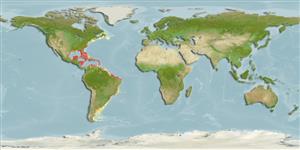Common names from other countries
Environment: milieu / climate zone / depth range / distribution range
Ecologia
; estuarina; intervalo de profundidade 0 - 45 m (Ref. 83917). Subtropical
Western Atlantic. Subtropical and tropical.
Length at first maturity / Tamanho / Peso / Idade
Maturity: Lm ? range ? - ? cm
Colonies for thin, upright blades or plates that are somewhat branched (Ref. 415).
In shallow reef habitats with surge or more flow that A. alcicornis habitats (Ref. 415). Colonial (Ref. 19). Known from mangroves (Ref. 86642).
Life cycle and mating behavior
Maturidade | Reprodução | Desova | Ovos | Fecundidade | Larvas
Reproduction occurs only in hydroid stage (Ref. 1663, p. 14).
Collin, R., M.C. Díaz, J. Norenburg, R.M. Rocha, J.A. Sánchez, M. Schulze, A. Schwartz and A. Valdés. 2005. (Ref. 415)
Status na Lista Vermelha da IUCN (Ref. 130435)
Status no CITES (Ref. 108899)
Not Evaluated
Uso pelos humanos
| FishSource |
Ferramentas
Mais informação
Idade/TamanhoCrescimentoComprimento-pesoComprimento-comprimentoMorfologiaLarvasAbundância
Fontes da internet
Estimates based on models
Preferred temperature
(Ref.
115969): 23.5 - 28, mean 26.9 (based on 250 cells).
Categoria de preço
Unknown.
